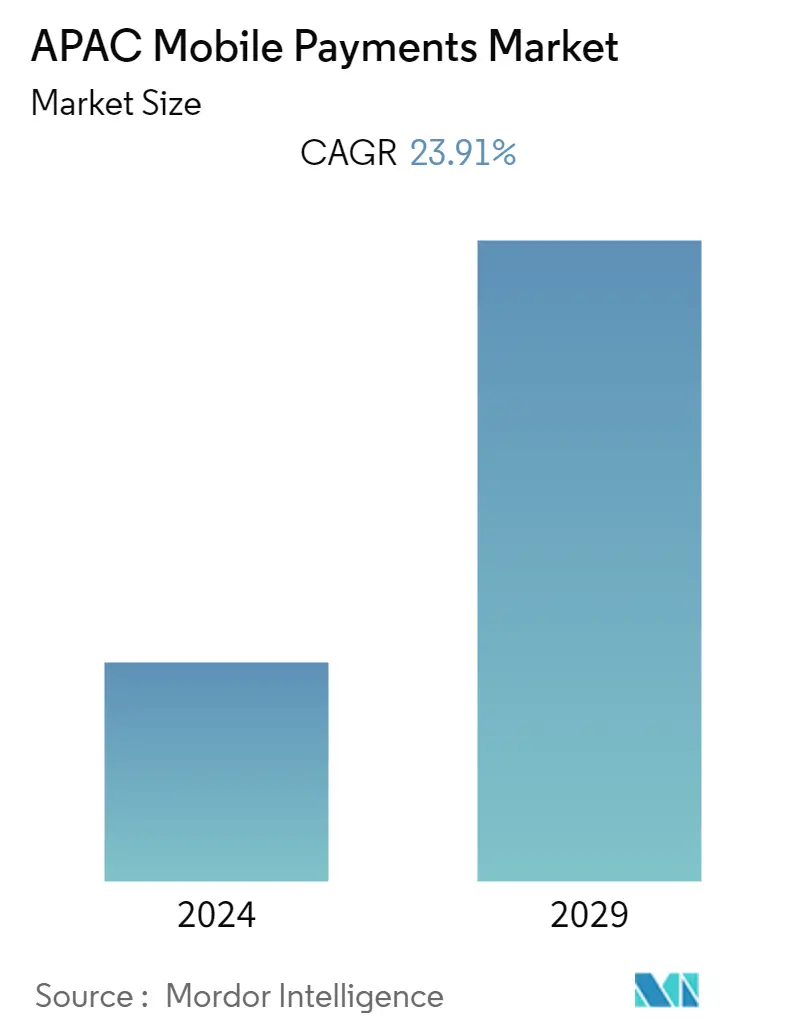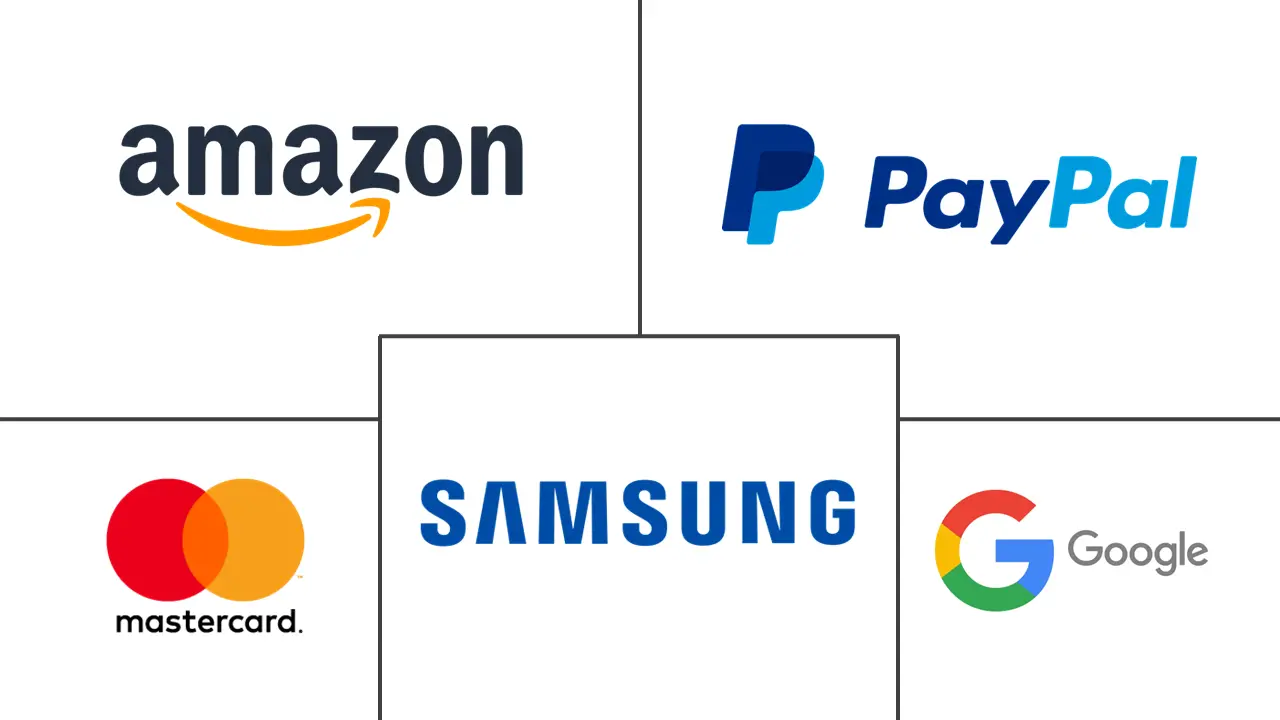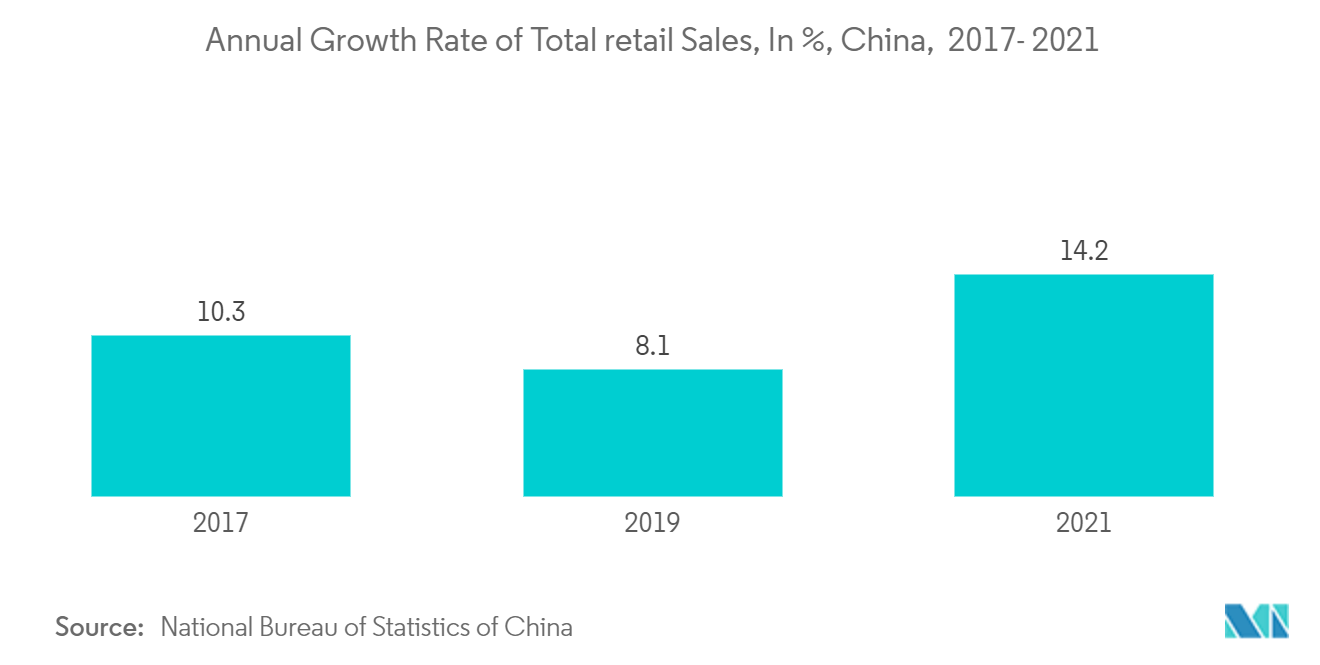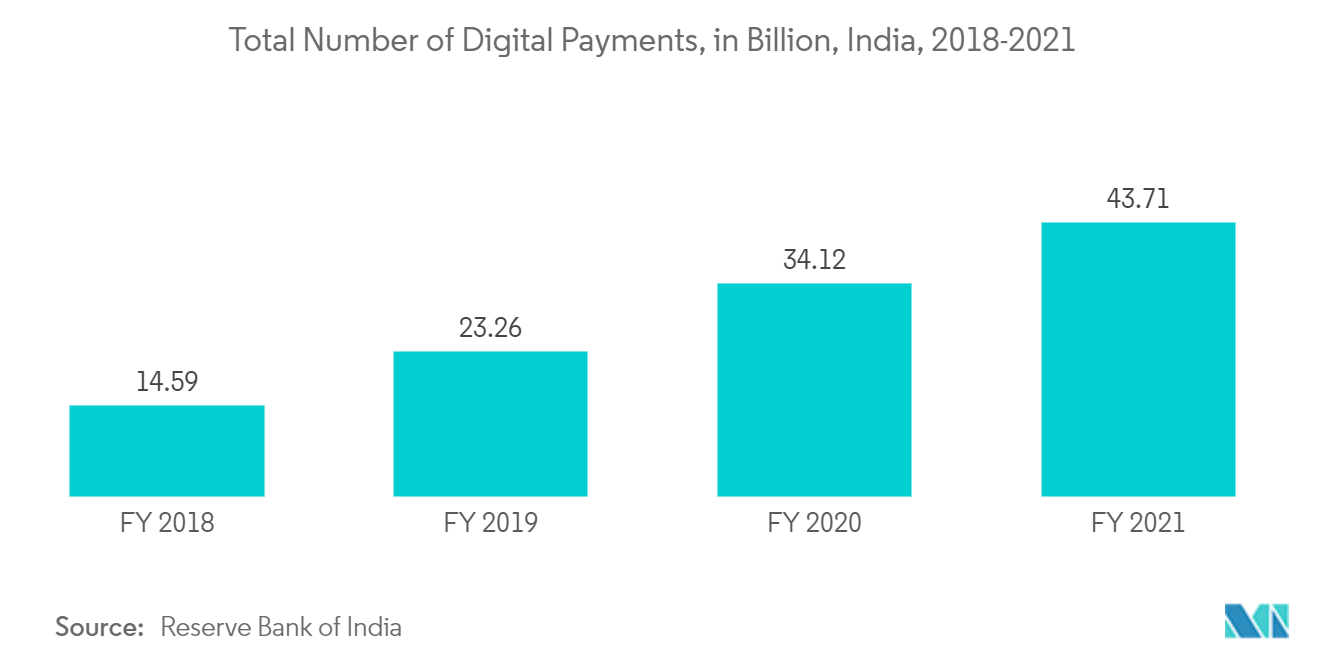APAC Mobile Payments Market Size

| Study Period | 2019 - 2029 |
| Base Year For Estimation | 2023 |
| Forecast Data Period | 2024 - 2029 |
| Historical Data Period | 2019 - 2022 |
| CAGR | 23.91 % |
| Market Concentration | Medium |
Major Players
*Disclaimer: Major Players sorted in no particular order |
APAC Mobile Payments Market Analysis
The Asia Pacific Mobile Payments Market is expected to grow at a CAGR of 23.91% over the forecast period (2022 - 2027). With the changing lifestyle, Increased smartphone penetration, and the latest online retailing trends, the mobile payments market in Asia-Pacific is expected to grow significantly over the forecast period.
- The mobile payment landscape across the Asia-Pacific region is changing rapidly, owing to unsettling digital transformation. The technological developments in the smartphone have enabled POS at retail terminals and on-the-go fund transfer, which are fueling the global market growth. Mobile payment platforms, such as Tencent, based in China, have witnessed robust growth. Tencent also expanded in other Asian countries, like Thailand, and it is searching for major partners that can help it localize its services in the country.
- According to the India Brand Equity Foundation (IBEF), India had over 1.18 billion mobile connections, 700 million internet users, and about 600 million smartphones as of October 2021. Each quarter has seen a sharp increase in these numbers. India led the world in terms of the volume of real-time payment transactions in 2020, with over 25.5 billion. Consequently, there is a raising need for smartphones. It is ultimately expanding the mobile payments market, further accelerating market expansion. The market is also growing due to increasing government efforts, funding, support, and funding from several large businesses.
- The rise of e-commerce and the O2O market has created an abundance of scenarios for people to adopt mobile payments in recent years. According to WorldPay, digital/mobile wallet is expected to occupy 60.2% of e-commerce payments by 2024 in the Asia-Pacific region, followed by credit card (16.1%). On the other hand, mobile payment played a crucial role in reducing friction and making on-demand, small-ticket services easily adoptable when they first began to emerge in the region. Rapid developments in these sectors, in turn, further drive the uptake in mobile payment usage.
- Increasing standardization and interoperability in cross-border payments are among the highest priorities for regulatory bodies. One such initiative is the ISO 20022 standard for messages across cross-border payments; the standard for electronic data interchange between financial institutions is expected to begin in late 2022 instead of November 2021 as SWIFT had initially planned; these delays are also hindering the market growth.
- The Ministry of Commerce (MOFCOM) and the National Health Commission (NHC) ministries of China collaborated to issue the 'Notice Concerning Properly Performing Life Services Enterprise Work to Prevent and Control the Spread of the Novel Coronavirus Infectious Pneumonia.' The notice requires the Chinese consumers to use swipe card payments and various types of mobile payments methods for settlement purposes during the COVID-19 outbreak.
APAC Mobile Payments Market Trends
This section covers the major market trends shaping the APAC Mobile Payments Market according to our research experts:
Retail Industry is one of the Factor Driving the Market
- The Asia Pacific region is anticipated to witness significant growth in the market studied as countries, such as China and India, adopt the digital mode of payment using digital and mobile wallets. The ubiquitous mobile devices, advanced digital infrastructure, and the growing usage of apps drive digital/mobile wallets, which are growing rapidly in the Asia-Pacific region. According to the global payment report 2020, digital and mobile wallets account for 58% of regional e-commerce payments and are expected to reach 68.2% by 2023.
- Further, the e-commerce sector is witnessing a spike in demand as consumers order essential items such as food and clothes, among others, through e-commerce websites, where most consumers prefer the digital mode of payment. According to the Reserve Bank of India's (RBI) digital payments index (DPI), launched in January 2021 to indicate the extent of digitization of payments in India, the index for September 2021 stood at 304.06 against 270.59 in March. This indicates the rapid adoption and deepening of mobile payments across the country.
- Some of the prominent players in the industry, through investments, have been able to better serve their consumers by providing them with safe and secure modes of mobile payment gateways. For instance, in July 2021, Digital payments giant Paytm, one of India's most valuable startups, plans to raise USD 2.2 billion in an initial public offering. Paytm, which was until recently the most valuable startup in India, intends to raise USD 268 million in a pre-IPO round.
- In August 2021, Aeon, a retail company established in Japan, announced the introduction of Aeon Pay, a mobile payment service, in September 2021. Aeon plans to combine its online shopping operations and prepaid cards under Aeon Pay to make its mobile payment service a nifty app that any retailer may use. The business is one of the newest participants in Japan's thriving mobile payment market. Internet companies compete to develop one-stop shopping options for various services, including banking, travel, and telephone access.
- According to the National Bureau of Statistics of China, In 2021, the total retail sales in China increased by around 14.2% compared to the 2109 year 8.1%. Such an increase in retail sales will drive the studied market in the region.

India to be the Fastest Growing Adopters of Mobile Payments
- The Indian market has historically been dominated by cash and is rapidly evolving to meet the demands of the digital payment culture; as a result of an increase in e-commerce and m-commerce culture, cards and digital wallets are rising in prominence. With the growth of various digital wallet companies in India, mobile payment is expected to increase.
- The demonetization scheme announced by Prime Minister Narendra Modi in 2016 led to a surge in the adoption of digital payments across the country. The government further bolstered cashless transactions through mobile devices by launching the BHIM application in 2016, based on the unified payment interface (UPI).
- Amid the coronavirus outbreak, India's government urged consumers to use digital payment methods as preventive and safety measures. Also, the RBI has proposed that customers use digital banking systems. NPCI also started an 'India pay safe' campaign to boost digital payments since exchanging cash could spread Coronavirus.
- UPI has proven to make the lives of many Indian users much easier. UPI is a popular real-time payment method that allows users to instantly transfer funds from one bank account to the other. There are several benefits associated with the UPI payments system, such as hassle-free online payments anywhere, a safe and secure mode of money transfer, and Users can make payments by scanning QR codes. These factors resulted in the dramatic rise of the UPI payments system as a preferred payment system in India.
- Furthermore, the UPI payment system is further increasing mobile payments by becoming a single user interface for all of an individual's bank accounts, eliminating the need to download multiple banking apps. Most banks and non-banks have adopted the UPI payment system. For instance, as per NPCI data, the number of banks that were live on UPI increased from 220 in April 2021 to 316 in April 2022.

APAC Mobile Payments Industry Overview
The Asia Pacific Mobile Payments Market is moderately consolidated with the presence of significant market players such as Google LLC, Apple Inc., PayPal Inc., MasterCard Inc, Visa Inc., and American Express Co. The companies are introducing new offerings, continuously investing in partnerships and acquisitions, and product development to increase the market share. A few of the recent actions by the companies are listed below.
- January 2022 - MoneyGram International, Inc., a key player in the development of digital P2P payments, recently announced a strategic alliance with Digital Wallet Corporation, a global fintech firm and the operator of Smiles Mobile Remittance (Smiles), a mobile money transfer service and digital wallet in Japan. Digital Wallet Corporation also owns Smiles. With the use of MoneyGram's worldwide payment rails and near real-time capabilities, customers in Japan may now send money to more than 200 countries and territories using the Smiles mobile app.
- December 2021 - Vietnamese mobile payment app, MoMo secured USD 200 million in a Series E investment round from international investors. Mizuho Bank took the lead in the round, with contributions from Mizuho, Ward Ferry, Goodwater Capital, and Kora Management. With the additional capital, the company intends to strengthen its position in the market, broaden the scope of its solutions, and encourage foreign investment in Vietnamese firms to develop the ecosystem. Additionally, it intends to expand its services in rural areas, tier two and three cities, and smaller towns.
APAC Mobile Payments Market Leaders
-
Google LLC
-
Samsung Group
-
Amazon.com Inc.
-
Paypal Inc.
-
Mastercard Inc.
*Disclaimer: Major Players sorted in no particular order

APAC Mobile Payments Market News
- June 2022 - ComfortDelGro Taxi and Alipay+ announced a partnership that enables mobile payments from Malaysia and South Korea, namely the Touch 'n Go eWallet and Kakao Pay, to be accepted as cashless payment options in all its Comfort and CityCab taxis. Users of these mobile wallets can pay for the cab fare simply through the wallet apps without needing to exchange currency.
- March 2022 - HDFC Bank announced refurbishing its PayZapp app and launching it as a complete payments app called PayZapp 2.0 on the latest digital technology platform. The bank believes this app will leverage its existing strengths, such as its 60-million-strong debit and credit card franchise. Unlike its earlier version, PayZapp 2.0 will have Unified Payments Interface payments enabled. It will include various payment options, including modes like tap and pay to transact at all merchant establishments with the required enablement.
APAC Mobile Payments Market Report - Table of Contents
1. INTRODUCTION
- 1.1 Study Assumptions and Market Definition
- 1.2 Scope of the Study
2. RESEARCH METHODOLOGY
3. EXECUTIVE SUMMARY
4. MARKET INSIGHTS
- 4.1 Market Overview
-
4.2 Industry Attractiveness - Porter's Five Forces Analysis
- 4.2.1 Bargaining Power of Suppliers
- 4.2.2 Bargaining Power of Buyers
- 4.2.3 Threat of New Entrants
- 4.2.4 Intensity of Competitive Rivalry
- 4.2.5 Threat of Substitutes
- 4.3 Assessment of Impact of COVID-19 on the Market
5. MARKET DYNAMICS
-
5.1 Market Drivers
- 5.1.1 Increasing Internet Penetration and Growing M-commerce Market
-
5.2 Market Restraints
- 5.2.1 Security Issues Associated with Mobile Payments
6. MARKET SEGMENTATION
-
6.1 By Type
- 6.1.1 Proximity Payment
- 6.1.2 Remote Payment
-
6.2 By End-User Industry
- 6.2.1 BFSI
- 6.2.2 IT and Telecommunication
- 6.2.3 Retail
- 6.2.4 Healthcare
- 6.2.5 Government
- 6.2.6 Media and Entertainment
- 6.2.7 Transportation and Logistics
- 6.2.8 Other End User
-
6.3 By Country
- 6.3.1 China
- 6.3.2 India
- 6.3.3 Japan
- 6.3.4 South Korea
- 6.3.5 Rest of Asia Pacific (includes Philippines, Vietnam, Malaysia, Australia)
7. COMPETITIVE LANDSCAPE
-
7.1 Company Profiles
- 7.1.1 Google LLC
- 7.1.2 Samsung Group
- 7.1.3 Amazon.com Inc.
- 7.1.4 Paypal Inc.
- 7.1.5 Mastercard Inc.
- 7.1.6 Visa Inc.
- 7.1.7 American Express Co.
- 7.1.8 Comviva Technologies Limited (A Tech Mahindra Company)
- 7.1.9 WeChat (Tencent Holdings Limited)
- 7.1.10 Alipay.com Co. Ltd
- 7.1.11 Paytm (One97 Communications Limited)
- *List Not Exhaustive
8. INVESTMENT ANALYSIS
9. FUTURE OF THE MARKET
** Subject To AvailablityAPAC Mobile Payments Industry Segmentation
Mobile payments refer to transactions under the purview of various regulatory bodies using mobile devices as part of initiatives to digitize payments. Mobile device payments are alternatives to cash, cheques, or physical credit cards.
The Asia Pacific Mobile Payments Market is segmented by Type (Proximity Payment, Remote Payment), By End User (BFSI, IT and Telecommunication, Retail, Healthcare, Government, Media and Entertainment, Transportation and Logistics), and Country.
| By Type | Proximity Payment |
| Remote Payment | |
| By End-User Industry | BFSI |
| IT and Telecommunication | |
| Retail | |
| Healthcare | |
| Government | |
| Media and Entertainment | |
| Transportation and Logistics | |
| Other End User | |
| By Country | China |
| India | |
| Japan | |
| South Korea | |
| Rest of Asia Pacific (includes Philippines, Vietnam, Malaysia, Australia) |
APAC Mobile Payments Market Research FAQs
What is the current APAC Mobile Payments Market size?
The APAC Mobile Payments Market is projected to register a CAGR of 23.91% during the forecast period (2024-2029)
Who are the key players in APAC Mobile Payments Market?
Google LLC, Samsung Group, Amazon.com Inc., Paypal Inc. and Mastercard Inc. are the major companies operating in the APAC Mobile Payments Market.
What years does this APAC Mobile Payments Market cover?
The report covers the APAC Mobile Payments Market historical market size for years: 2019, 2020, 2021, 2022 and 2023. The report also forecasts the APAC Mobile Payments Market size for years: 2024, 2025, 2026, 2027, 2028 and 2029.
APAC Mobile Payments Industry Report
The Asia Pacific Mobile Wallet market is segmented by type, including proximity payment and remote payment, and by end users such as BFSI, IT and telecommunication, retail, healthcare, government, media and entertainment, and transportation and logistics. The market is further divided by country, covering China, India, Japan, South Korea, and the rest of Asia Pacific, including the Philippines, Vietnam, Malaysia, and Australia. The market sizes and forecasts are provided in terms of value for all segments.
The industry report provides a comprehensive market report, offering detailed market research on the market share and market size. An industry overview is included, along with a market forecast. The report also delves into the industry analysis, providing industry information and an industry outlook. It highlights industry sales, industry trends, and industry statistics, giving a thorough analysis of the market data.
Market growth is a key focus, with insights into market leaders and market outlook. The market overview includes market predictions and a market review, along with market segmentation and market value. The report example is available as a report pdf, useful for research companies seeking detailed insights.
Additionally, growth rate and industry analysis are emphasized throughout the report, ensuring a thorough understanding of the market dynamics. The industry reports and industry research sections provide valuable information for stakeholders. The industry size and market forecast sections offer projections and future outlooks, while the market growth and market leaders sections highlight key players and trends.
Overall, this report serves as a crucial resource for understanding the Asia Pacific Mobile Wallet market, offering in-depth analysis, market data, and valuable insights for industry professionals.



